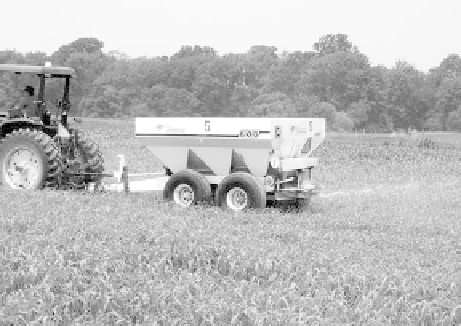Agriculture Reference
In-Depth Information
At this point, you begin to see that harvesting grain from one hectare removes
nitrogen, potassium, and phosphorus from that hectare. If these nutrients are not
replaced, next year's crop will yield less, and eventually the soil will become so
poor that we will not be able to raise enough maize to replace the seed used in planting.
Just to replace the nutrients carried off in the grain wagon, we must add 367 kg of
ammonium nitrate, 75 kg of potash, and 133 kg of triple superphosphate. To simplify
things, many farmers apply a fertilizer with these three elements combined. A fertilizer
identified as 27 - 13 - 10 will contain the equivalent of 27 percent N, 13 percent P
2
O
5
,
and 10 percent K
2
O in the bag. The rest of the bag is sand or lime. To replace the 125 kg
of nitrogen per hectare that our maize crop will remove, we will need to apply 463 kg of
the mixed fertilizer. For 10 ha of maize we will need to buy 4.7 tons of mixed fertilizer,
transport it to the field, and then spread it evenly on the soil. For the forage crop shown
in Figure 10.16 it only takes a few minutes to drive a machine over the crop field,
applying the correct ratio of nitrogen, phosphorus, and potassium fertilizers.
But what about all the other essential elements? Plants require these nutrients,
but only in vary small amounts. For example, the amount of copper removed by
9500 kg of grain will only be 68 g. This is easily replaced by the normal weathering
of minerals in the soil.
It would be misleading to assert that all farmers use chemical fertilizers. In
reality, most of the nutrients used by crops come from sources other than chemical fer-
tilizers. Chemical fertilizers supplement natural sources. As stated previously, natural
soil-forming processes release enough of most nutrients (copper, zinc, etc.) that we do
not normally have to worry about adding these to soils. For some soil types, natural
soil-forming processes release enough potassium to supply plant needs, but most
other soils require additions. Nitrogen and phosphorus are almost always limiting,
and farmers must constantly work to maintain these nutrients at adequate levels.
There are several nonchemical sources of nitrogen and phosphorus commonly used
in agriculture. Most farmers follow a 2- to 4-year rotation, repeating the same crop after
3 to 4 years. This means that one year a field will be planted to maize, the next year to
Figure
10.16.
Dry chemical fertilizer spreader.









